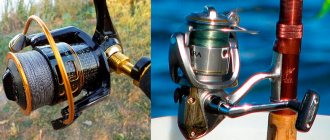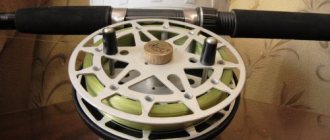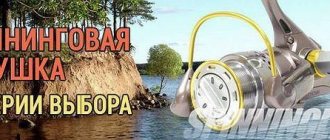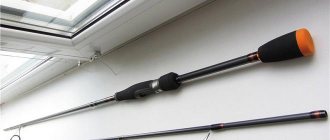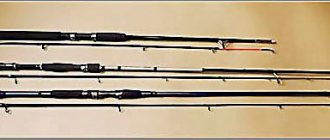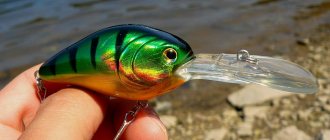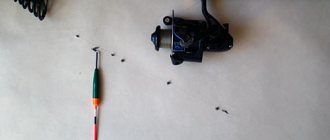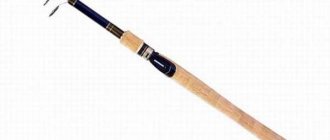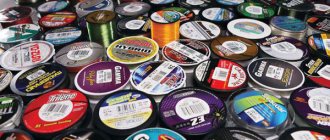Bobbin size
The size of the spool depends on the fishing method and the thickness of the fishing line. On reels you can find some values of 1000, 2000 or 5000. The number 1000 shows that the spool can hold 100 meters of fishing line with a thickness of 0.1 mm, and the number 3000 can hold one hundred meters of fishing line with a thickness of 0.3 mm.
- For light spinning (ultralight), reels with 1000-2500 spools are usually used.
- For medium spinning rod: 2500-3500.
- For heavy spinning, 4000+ spools are used.
- For feeder fishing, use reels with 2500-5000 spools.
- For carp fishing 5000+.
| Braid selection | Swimbait fishing | Types of inflatable boats | Chub fishing |
The size and depth of the spool should be selected depending on the length and diameter of the fishing line you are using and the casting distance of the bait.
Inertia-free coil device
Structurally, the coil consists of the following elements
:
• The body with a foot for attaching to the fishing rod is made of aluminum and magnesium alloys or light carbon or graphite composite materials. To give the coil maximum rigidity, the shape of the body and internal partitions is calculated on a computer. The shafts and gears of the mechanism are mounted on bearings inside the housing.
• The shafts and gears of the mechanism in expensive reel models are made of solid bronze and alloy steel, in cheap ones from silumin with bronze coating. By transmitting torque from the handle to the line roller, the gear mechanism of the reel increases the number of revolutions. In powerful power reels intended for catching and playing strong large fish, the gear ratio is from 3.2 to 4.3 to 1, in universal ones from 4.5 to 6.1 to 1, in high-speed ones (for jig or match fishing) from 6.1 to 7.2 to 1. The higher the gear ratio number, the more line is wound onto the bobbin per revolution of the reel handle.
• Reel spools are made of aluminum or plastic. To prevent the braided cord from slipping when winding onto the spool, on expensive reels the winding surface is rubberized. Manufacturers write on the outer surface of the spool what volume of fishing line and what diameter it is designed for.
• As the line layer rotates, it grabs the line with a roller and winds it onto the spool. The line is wound in a spiral, with the first turn of the line layer diagonally in one direction, followed by a cross on top of the first in the other direction. Depending on the profile of the spool installed on the reel, the line can be wound evenly or with a straight or reverse cone. When laying the line straight, the line flies at an average distance, spontaneous collections of the line are rare. Laying with a straight cone increases the casting distance and the likelihood of spontaneous dropping of the line. Laying with a reverse cone gives the least cast, but completely eliminates the spontaneous release of the line.
• Friction brake protects the reel from damage. With a strong tension on the fishing line, the spool turns on its axis, lowering the fishing line. The friction brake mechanism is installed by manufacturers at the front or rear of the reel. Both designs equally protect the reel from jerking and mechanism damage. When the brake is in the forward position, its adjustment knob is located on the spool; in the rear position, the tension is adjusted using a regulator located on the body.
• The reverse stop is located at the rear of the reel. When it is turned on, the line guide can only rotate in the direction of the line winding. When it is turned off and the line arc is lowered, the handle rotates in both directions and the line comes off the spool freely.
• The reel handle is made of aluminum or hard plastic. To reduce the size of the reel in the transport position, the handle folds 90° using a button or hinge. For ease of working with the reel, the handle can be installed on the left or right side. To do this, you need to unscrew the nut and pull out the handle shaft. On most reels, the handle has one handle; some speed reels are equipped with handles with two handles for better balancing.
Spool shape
Deep spools hold a larger amount of fishing line, the casting range with such spools is low, and are used for thick braided or monofilament fishing line.
Shallow Air Spool spools are mainly used for thin braided lines. Typically, such spools have an increased diameter.
Long Cast spools are commonly used on carp reels. The long cone-shaped spool provides good capacity and long casting.
There are also reverse taper spools that are used for spinning reels. The reverse cone eliminates loop shedding and reduces the risk of line tangling.

Spinning reels - main characteristics
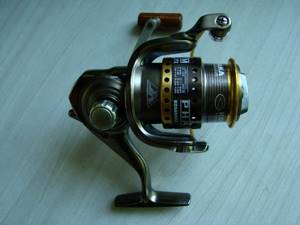
For each spinning direction, special requirements are imposed on the reels, which determine their ability to ensure 100% suitability of the gear for specific baits and equipment, their correct presentation, and the ability to catch fish in the given conditions.
The main parameters of any spinning reel are:
- size; - weight; – reduction; – type of friction brake; – line capacity of the spool.
Therefore, before choosing a reel for a specific fishing direction, you need to evaluate all the performance characteristics as a whole.
Spinner size
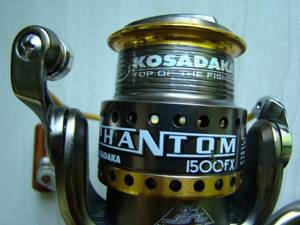
This indicator is perhaps the most important. The smallest coil is marked with the numbers “500”, the designation of the largest one can reach the value “20000”. In our conditions, it is customary for spinning anglers to use spinning rods ranging in size from 1000 to 6000:
1000 – 2000 – coils for ultralight; 1500 – 2500 – reels for light fishing; 2500 – 4000 – spinning rods for “adult” spinning rods; from 3500 – “heavy” and trophy fishing.
Naturally, the size range of coils from different manufacturers differs and does not correspond to each other. Therefore, it is customary to take products from the Japanese concern Shimano as a standard. This is a generally recognized leader in the fishing goods market.
Inertia-free or multiplier for ultralight - which reel is preferable? What type of reel – multiplier or spinning reel should you prefer for ultralight fishing? The question is not so simple, and the answer depends, among other things, on the experience of the fisherman and the time of use of this or that gear.
Coil gear ratio
The inertia-free reduction shows how many revolutions the spool makes with one full revolution of the handle.
According to this indicator, all “meat grinders” are divided into:
– power; – universal; - fast.
Power ones have a reduction from 3.2:1 to 4.6:1 . These are powerful “winches” capable of developing high traction force. They are used in heavy jigging, fishing with large and stubborn baits, trophy hunting, lake and river trolling.
Heavy jig reels >>
Inertia-free reels with gear ratios from 4.8:1 to 5.5:1 are considered universal reels. In terms of traction indicators they are inferior to power ones, but they are much more variable in terms of fishing techniques and the speed of feeding the bait.
They are in demand everywhere – from ultralight to all types of “adult” spinning rods.
“Meat grinders” with a reduction of 5.5:1 are called high-speed . They are used in light spinning rods with small baits and when hunting small fish that do not offer decent resistance. Suitable for catching trout, grayling, perch, chub, rudd and other white representatives of the ichthyofauna.
Weight of spinning reel
The weight of a spinning reel is no less significant than those described above. Correctly selected reel weight will ensure the overall harmony of the gear. An imbalance, on the contrary, will lead to the fact that the fishing rod will either “peck” at the tip or tip over. As a result, the angler will not be able to fully perform the retrieve and control the behavior of the bait; it will be difficult for him to fish all day without getting tired of the constant need to balance the spinning rod with his hand.
Ultralight coils weigh about 200 grams.
In “adult” spinning rods, models are used whose weight reaches 250–400 grams.
When fishing with heavy baits and hunting trophy underwater inhabitants, this characteristic can reach 500–600 and even 700 grams.
Friction brake
Friction is an important part of any inertia-free system. It is this that prevents the line from breaking when the loads become critical. A good, sensitive braking mechanism will release the thread from the spool in the event of sudden jerks of the predator or a sudden snag on an underwater obstacle.
There are two types of friction mechanism: front and rear.
The majority of spinning reels have a front drag. It is located on the spool, which allows you to reduce the size and weight of the spinning machine. For most people, this brake location is more convenient.
Rear drag is more common on feeder and match reels. It is generally accepted that it is more subtle in adjustment, but not as comfortable as the front one.
Spool material
The spool can be made of either plastic or metal.
It is better to avoid plastic spools, as they wear out quickly and have high friction. Braid on plastic spools will not be used.
Metal spools are usually made from aluminum, while more expensive ones are made from titanium or composites. There are also aluminum spools coated with titanium nitrite, which have a very smooth surface, wear resistance and strength.
Reels with hard-coated aluminum spools are much more expensive than regular reels.
| Aluminum boats | Coastal echo sounders | Types of jig heads | Carp rods |
Friction clutch
An element of a spinning reel that allows you to release the cord or line when reeling in a fish so as not to tear the line or the fish’s lip. With strong jerks, you need to let the fish unwind the line from the reel, as the fish gets tired and cannot break the line. The clutch can be rear or front.
For spinning, reels with a front drag are usually used.
For feeder or carp fishing, reels with a rear drag and a baitrunner are used.

The front clutch is considered more sensitive and more reliable and is more finely adjusted.
What to look for when choosing a reel
Choice is always a difficult matter. Each manufacturer has many lines with different sizes. Not only a beginner, but also an experienced spinning player will not be able to immediately understand the wide range of reels and their characteristics in order to make the right decision about purchasing the right model.
Number of bearings
One of the main characteristics of the reel that people pay attention to. The quantity can reach up to 13 pieces. They serve for smooth and soft operation of all components and mechanisms of the reel. Some little-known manufacturers mislead buyers by indicating a large number of bearings, which in reality may be half as many.
Instead of bearings there are plastic bushings, which have a shorter service life and reliability. For reliable, soft operation, 4-6 bearings in the design are sufficient. All the rest do not provide additional useful properties, but significantly increase the cost of the finished product. Bearings must be periodically cleaned and lubricated to prevent premature wear and failure.
It is recommended to choose a reel that has a metal bearing in the line roller. This element is subject to constant loads and contamination. If the roller does not function, the line or braided cord will be subject to high friction, and the cord will soon easily cut a groove in the roller.
The relationship between the diameter of the fishing line and its quantity
Each spool has a capacity indicated, that is, how many meters of fishing line of a certain diameter the spool can hold. It is necessary to select a reel for the diameter of the fishing line used so that it can accommodate at least 100 - 150 meters. There is no general classification of coils by size. But most anglers are accustomed to relying on the system from Shimano, where reels are classified by size 1000, 2000, 2500, 3000, 4000, 5000, 6000.
Having similar sizes of reels from other manufacturers, the capacity of their spools may not coincide with the capacity of Shimanov's. The designation 0.3/150 indicates that 150 meters of monofilament line with a diameter of 0.3 mm can be wound onto the spool.
Brake clutch
Spinning reels can have two types of friction brake: front and rear. It is necessary to prevent rotation of the spool when winding under load, as well as to release the line during strong jerks of the fish. This prevents the line from breaking if its breaking load is significantly less than the effort during fishing.
The front friction brake is located on the spool, the rear at the end of the reel. For spinning fishing, the front drag is considered preferable. It is simpler, more convenient, has greater smoothness and accuracy of adjustment.
Reels with rear drag are used for feeder or carp fishing, when it is impossible to immediately and precisely adjust the drag to the expected size of the fish. In this type of fishing, the fisherman does not hold the rod directly in his hands until he bites. When fishing for large carp, reels with a rear drag and a baitrunner are used, which resets all clutch settings at the first sharp jerk of the fish in order to avoid breakage of the equipment.
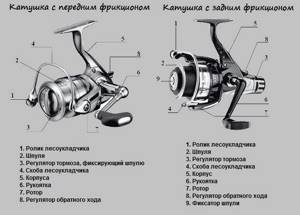
Long casting system
Casting range is an important component for a spinning player. The farther you can throw the bait, the larger the area you can fish. There are several methods to increase the casting distance of a reel. Some manufacturers use a special spool shape, tapered, when the spool increases towards the base of the reel. The farther turns of the line have a larger winding diameter than those at the edge of the spool. This allows them to come off without additional friction on the spool collar. Such spools are usually used when fishing for carp.
The casting distance can be increased by correct winding of the fishing line on the spool, when the turns cross, and do not lie next to each other, drowning the honey with adjacent turns. This laying system is achieved with an endless screw (worm gear). However, it is worth noting that the Daiva company refused to use an endless screw even in top models. But this did not stop it from achieving perfectly correct winding.
Casting distance can be increased by using reels with larger spools and shallower spool depths. This allows the line to flow more freely without additional friction on the spool collar with the lower turns.
Spare spool
A nice bonus that not every manufacturer provides for a specific model. A spare spool is necessary when fishing you need to change equipment to a more sensitive one or, conversely, with a higher breaking load. This is much cheaper than buying a completely new additional set of spinning rod and reel.
Traction force
An important component that few people pay attention to. Indicated in kilograms. This is the maximum force that the reel can handle when landing fish without the help of a rod, that is, working like a winch. For fishing with heavy, stubborn baits or large fish, it is recommended to use reels with a pulling force of at least 5 kg. Otherwise, the reel can simply be “killed” by frequent idle casts in just a few seasons.
Gear ratio
For spinning fishing it is not of great importance, since it is not the speed of winding the line onto the reel that is important, but the correct action of the bait. This indicator is important when fishing with a match, feeder, or carp rod, where the speed of reeling and new casting is very important for saving time.
Spool material
They can be made from light alloys, plastic, graphite. Plastic spools are used only if monofilament fishing line is used. The braided cord will cut through it. Light alloy spools are preferred for spinning fishing. To protect the spool from wear, its collar must be coated with titanium nitrite.
Reel weight
As a rule, experienced spinningists pay attention to this parameter, or if a reel for ultralight tackle is needed. Less weight will reduce stress on your arms. It is more pleasant to fish with light tackle; you don’t feel tired after a hard day of fishing. Less weight gives the spinning tackle greater balance.
Bayrunner
A baitrunner is a special mechanism for releasing a fishing line or cord. That is, when the baitrunner bracket is pulled back, the reel spool begins to bleed out the line, and when you press the bracket back, the spool stops bleeding out the line, which is very convenient.

Baitrunner is most often used in carp and feeder fishing.
The baitrunner can also be used as a bite alarm, since during the jerk the fish will pull the line from the reel, which will be accompanied by a characteristic crack that can be heard ten to twenty meters away.
Reel weight
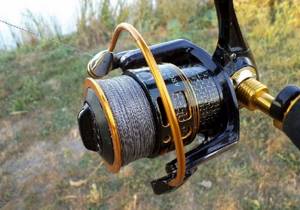
On the other hand, saving on the materials of the reel parts, which should be made of metal, increases the weight of the reel. Therefore, it is worth looking for some balance and knowing that the reliability and durability of the reel is still more important than its lightness.
In other words, the heavier the reel, the more reliable it is, but not always. The most modern reels can be made from composite materials, which are stronger and lighter than aluminum, but are much more expensive.
The weight of the reel plays an important role in the overall balance of the tackle. The balance of the tackle is the correct center of gravity of the rod and reel; the closer it is to the reel handle, the better. This balance puts less strain on the hand and allows for more efficient wiring.
Particularly light reels are important in ultralight, when the spinning rod itself and baits are as light as possible. The average weight of ultralight reels is 200-260 grams.
Aluminum housings of spinning reels are less deformed under loads, which increases their service life.
Secrets of successful fishing: Inertia-free reels with a closed spool
Closed coils
— inertia-free reels with a closed spool are designed to greatly simplify casting and reduce the possibility of line tangling. It is clear that this is achieved to the detriment of other properties.
USEFUL INFORMATION
Introduced in the 1950s, closed reels have become popular, especially among beginners, because they are easier to cast than other types of reels. Inspired by demand, manufacturers in all parts of the world flooded the market with closed coils of their own designs, so the task arose of making a single and, at the same time, cheap coil. Currently, there are a huge number of different models of closed coils, but the demand for them is falling. Many fishermen believe that inertia-free closed reels have such a bunch of shortcomings that they should be immediately excluded from the arsenal, as unsuitable for any kind of harsh fishing. The main advantage of a closed coil has already been named: it is simple in appearance. In addition, a reel with a closed spool makes it possible to control the line even in very windy weather (it passes through a hole in a completely closed body), which is unrealistic when using an open-type spinning reel, because the turns of the line can wrap around the bracket.
Necessary ADVICE
If the fishing line bends around a metal axis when winding, you should use a fishing line with a strength of 0.9-2.2 kg. The use of thick fishing line is harmful to the sensitive mechanism of closed reels. The disadvantages should first include the short casting range due to the wealth of parts that the fishing line rubs against. For the same reason, the angler does not feel the tension of the fishing line when reeling in. Since a huge number of surfaces guide the fishing line, it becomes rough, which in turn causes the parts of the reel itself to wear out. Damage to the fishing line from pebbles and similar obstacles also contributes to rapid wear of parts. The friction brake of closed reels will be applied by a gear mechanism to the reel handle. For this reason, the brake action may not be felt and a preparatory jerk is required, after which the brake acts more sensitively. In some reel designs, the brake operation is automated.
Necessary ADVICE
A more common method of reducing braking force is to turn the handle in the opposite direction. With all this, naturally, skill in handling a reel is required, which can be achieved, for example, by training on land. The best-designed closed reels are equipped with line guides made of very strong metal. In cheap reels, the line is placed on the spool thanks to a winding cup with a wavy edge, which wears out the line because it forms an acute angle with it. Since in the front part of the protective cap the hole for the line to exit is small, which causes friction, in some reels the end hole was enlarged to the size of the spool. Such coils are considered semi-closed. Casting with closed reels is usually done by pressing the trigger lever all the way. In this case, the fishing line is pressed against the sides of the protective cap, and the line guides release it. When the lever is released, the line carried by the lure runs off the spool. To attach a closed reel, it is required that the rod have a saddle-shaped handle, in other words, a twist, or “saddle”. A closed reel can also be attached to a straight rod, but in this case the lure is cast with 2 hands.
Coil load
Regarding the load, it is only worth noting that the larger the reel, the larger its internal parts, and as a result, in theory, it should withstand heavy loads and be able to install large spools. This is why carp reels are made so large.
The load on the friction brake is also affected by the gear ratio of the coil. The lower the number, the more powerful the traction coil.
Example: a reel with a gear ratio of 4:1 will be more powerful than a similar reel with a gear ratio of 5.5:1.

Reel classification
The industry produces versions of spinning reels for float, spinning, and feeder fishing. Reels differ in spool volume, power and gear ratio of the mechanism. By power, reels are divided into light (500 - 2000), medium (3000 - 4000) and heavy (5000 - 12000). The higher the number, the larger the volume of the spool, the thicker the fishing line used, and the more massive the gears of the mechanism. Typically, the reel number is engraved on the spool.
Inertia-free reels are produced in Europe, America and Asia. The leading manufacturers are considered to be the following companies:
• Shimano.
• Daiwa.
• Salmo.
• Ryobi.
• Mikado.
• Tsurinoya.
Reel handles
Handles come in the following types:
- screw-in
- screw fastening
- with rivet.
There are no particular differences in operation between the types of fastening, but the handle itself should be comfortable and reliable. Preference is given to handles made of metal or hard plastic that are rubberized and without significant play and do not bend under load.
When choosing a spinning reel, pay attention to the play of the handle; the smaller the play, the better.
How to choose a spinning reel
Before purchasing a reel, a fisherman must decide in which body of water he will fish, what type of spinning rod he will use, what bait to use, and whether the reel will be used only for spinning fishing. After this, the required reel power and spool size are selected.
When choosing coils, pay attention to the following
:
• The power of the reel must correspond to the spinning test. Almost weightless ultralight and light rods are equipped with reels of size 800 - 2000, and for medium ones - 2000 - 3000. Reels of higher power are purchased for trolling or sea fishing.
• While fishing, the angler constantly holds the spinning rod in his hands. The lighter the reel, the less your hands get tired. At the same price, it is worth purchasing a reel of less weight.
• The reel roller must be coated with hard materials (steel, bronze, brass). To prevent abrasion, it must spin well on the bearing.
• The line brace must be securely locked in the open position when casting bait.
• When purchasing an inexpensive reel, the edges of the spool are checked for smoothness. In order for the cord or fishing line to come off easily and quickly when casting the bait, the edges of the side should be rounded and there should be no burrs on them.
• When rotating the reel handle, the mechanism should not creak or crunch. Rotation should be smooth, without jamming.
• The reel handle shaft should not play when the handle is rotated. The handle should easily fold into transport position.
• The spool must be firmly fixed on the shaft; play of the shaft perpendicular to the spool axis is not allowed.
• It is considered optimal if there are 5 – 7 bearings installed inside the reel. A smaller number indicates a low motor life of the mechanism; a larger number is used in expensive elite models of reels or in Asian ones with an overly complex mechanism design.
• The included interchangeable spool gives the reel versatility. You can wind a cord or fishing line of a different diameter on the second spool and use the reel for bottom or float fishing. Large companies produce and sell additional spools for their reels.
Bearings
It is worth noting here that the more there are, the better, since the reel parts will have less friction and, accordingly, will be more durable. And overall the reel will be smoother and more enjoyable.
Reel bearings vary in quality and shape. There are ball and roller bearings. Roller bearings are considered more efficient.
Here are the main parameters of the coils that you need to pay attention to. When comparing similar reels, you should give preference to reels from Daiwa, Shimano and Ryobi, as they have long been considered among the highest quality and most reliable.

